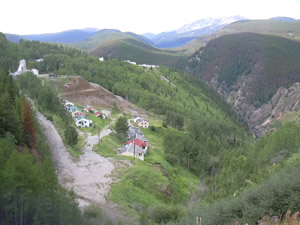
By Tom Boyd
Eagle County a prime example of why we need to reform 1872 mining law
July 20, 2009 —
Living in Eagle County, we know a little bit about hard-rock mining waste. We've been cleaning up the badly contaminated Eagle River for decades, and evidence of our rich but rowdy mining history from the late 1800s is everywhere (as are piles of mine tailing and leftover mining equipment).
When I first moved to Vail in 1991 the Eagle River literally ran orange from zinc mining, and much of the land around the old abandoned company town Gilman is still an EPA Superfund Cleanup site.
But unlike oil and gas extraction, pulling hard-rock minerals like uranium, gold and copper out of the ground is a royalty-free proposition in the United States, despite the often enormous costs of cleaning up public lands after the fact.
The Environmental Protection Agency in a filing last week noted that hard-rock mining has impacted 40 percent of all western watersheds and that nationwide 28 percent of the toxic pollution generated in the United States comes from the mining industry –- the most of any sector. The EPA also concluded mining represents a major taxpayer burden because of cleanup costs.
The EPA filing was presented during a hearing last week of the U.S. Senate Energy and Natural Resources Committee chaired by Colorado Sen. Mark Udall. Former Colorado Sen. Ken Salazar, now Secretary of the Interior, testified the Obama administration wants to see the 1872 Mining Law reformed in the current Congress.
Mining reform legislation has been introduced in both the House and the Senate, and both versions would set up some sort of royalty structure for hard-rock mining on federal lands. The 137-year-old system of filing for relatively inexpensive and easy-to-acquire “patents” would be scrapped, and a fund would be set up to pay for massive cleanup efforts that for decades have been passed off to taxpayers when mining companies go bankrupt.
The Summitville gold mining disaster in Colorado, for instance, has cost taxpayers more than $200 million in cleanup costs. Reform advocates say the law passed in 1872 by the Grant administration was designed to encourage settlement of the West but is now antiquated and dangerous for the descendants of those settlers.
“We’re going back to the future on 1872 mining reform. This legislation is long overdue,” said Denver-based Environment Colorado advocate Matt Garrington. “Colorado is beautiful country, and we need to protect treasures such as Dolores Canyon from the impacts of uranium mining.”
The Dolores River Canyon is a proposed wilderness area in southwest Colorado threatened by nearby uranium mining claims, which increased 239 percent on public lands in Colorado between 2003 and 2007. Some of those claims are encroaching on national treasures like the Grand Canyon and Arches National Park, conservationists point out.
“A lot has changed since 1872. The West is settled, and agriculture, tourism, and outdoor recreation are primary economic drivers for mountain towns,” state Sen. Gail Schwartz, D-Snowmass Village, said in a release. “We need sensible mining policy. Colorado has taken steps toward reform. Now, Washington has an opportunity to make sensible decisions about public land management and to protect our water.”
Salazar likely will get a fight from Sen. Majority Leader Harry Reid, D-Nevada, who in the past has blocked reform measures because of gold mining interests in his home state.
This week Salazar issued a notice of withdrawal of nearly 1 million acres of Bureau of Land Management and U.S. Forest Service land around the Grand Canyon from new mining claims for the next two years to allow for more study and analysis.
The move drew the praise of conservation groups such as the Pew Environment Group, which has been hammering on the antiquated 1872 mining law and the pressing need for reform in light of thousands of new mining claims in and around the national parks.
“We are pleased that the Obama administration has encouraged Congress to protect our national parks and other special places by modernizing the country’s 1872 mining law,” Jane Danowitz, U.S. public lands program director at the Pew Environment Group, said in a release. “Clearly a law that is powerless to prevent mining just outside one of the most iconic treasures in the world needs to be reformed.”
Also this week, Pew announced a new Google Earth interactive project showing the extent to which national parks and other vacation destinations are being encroached on by lightly regulated miningclaims. The project is called “Check out the View from Route 1872.”
![]() Comment on "Eagle County a prime example of why we need to reform 1872 mining law" using the form below
Comment on "Eagle County a prime example of why we need to reform 1872 mining law" using the form below












